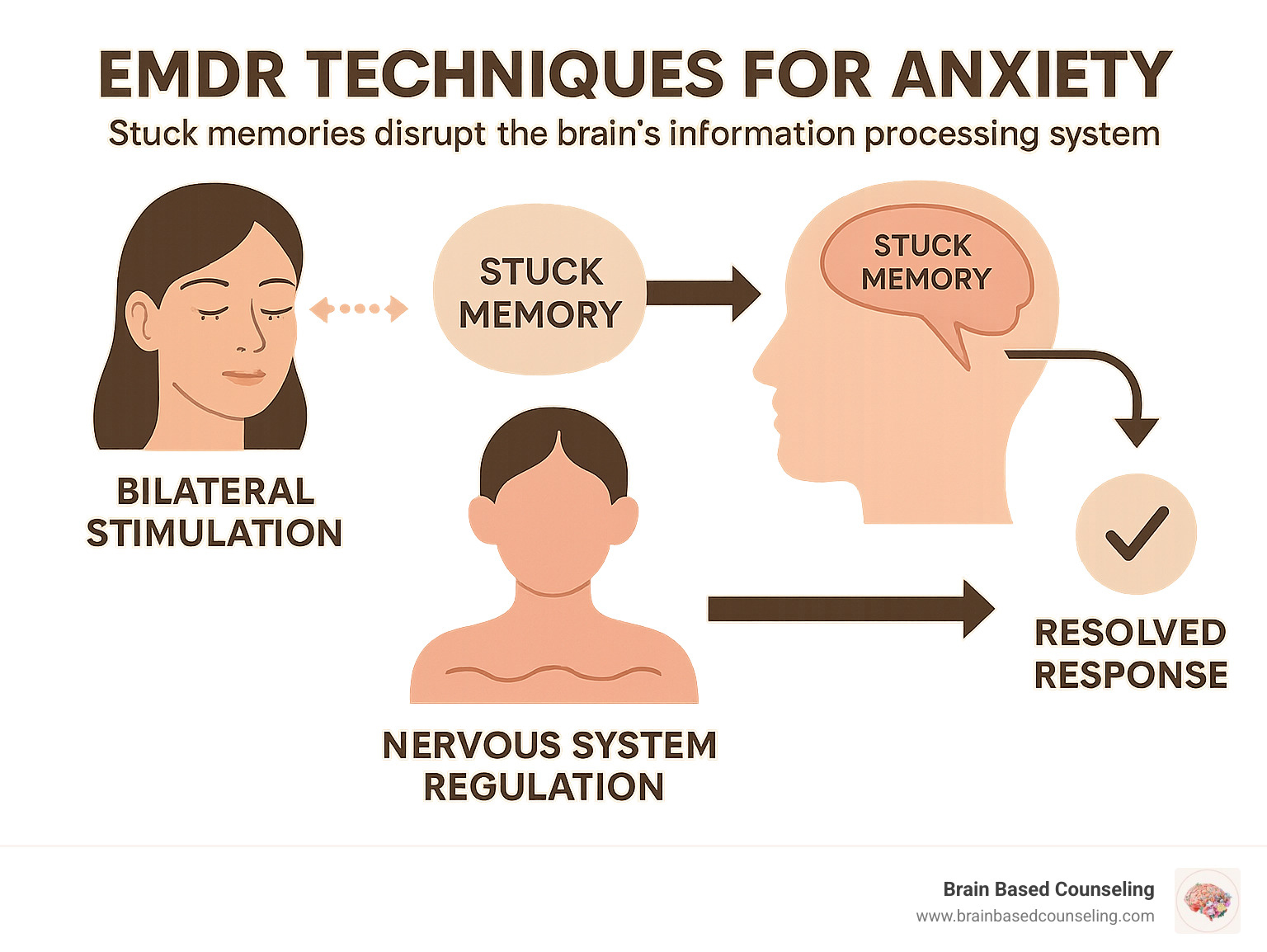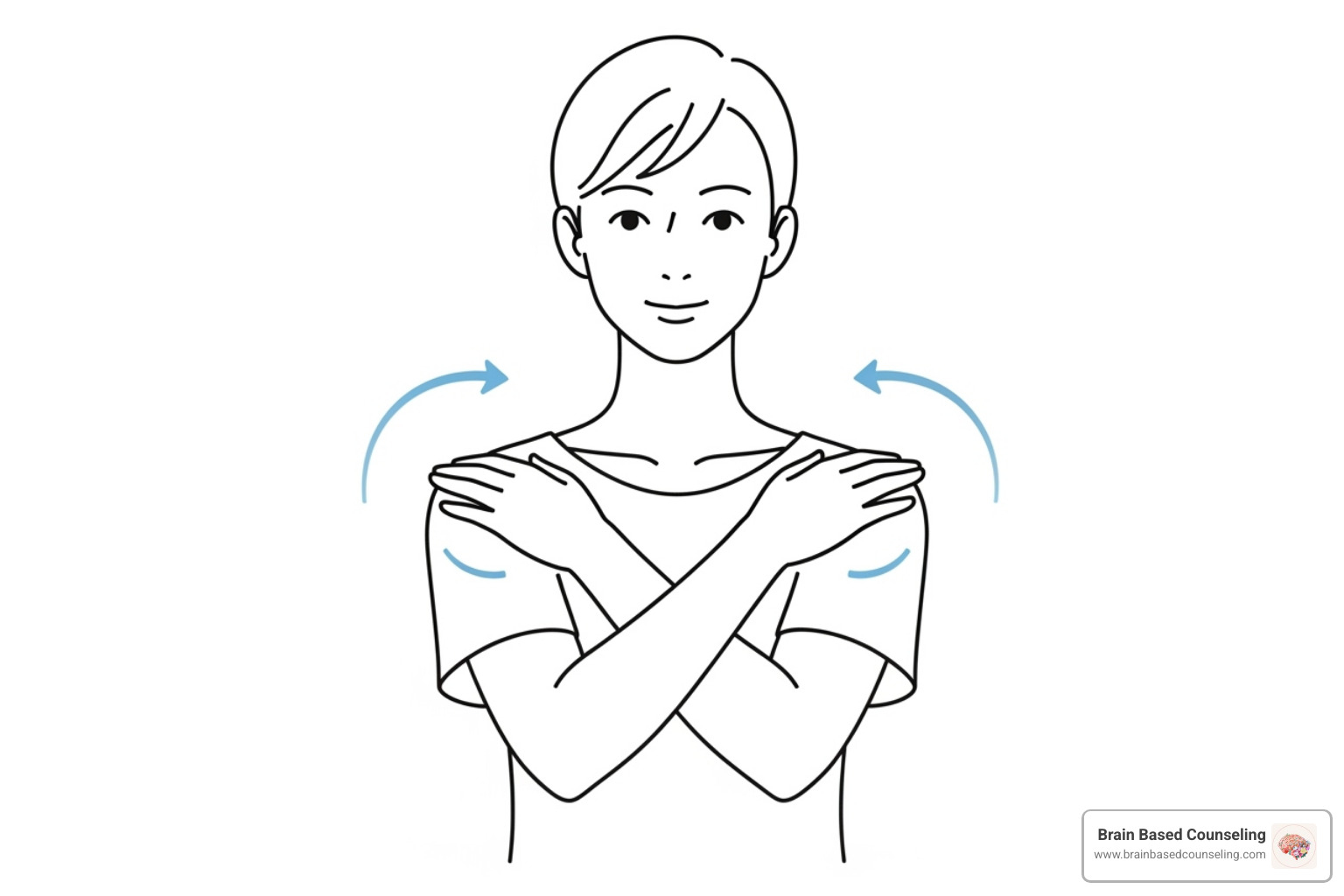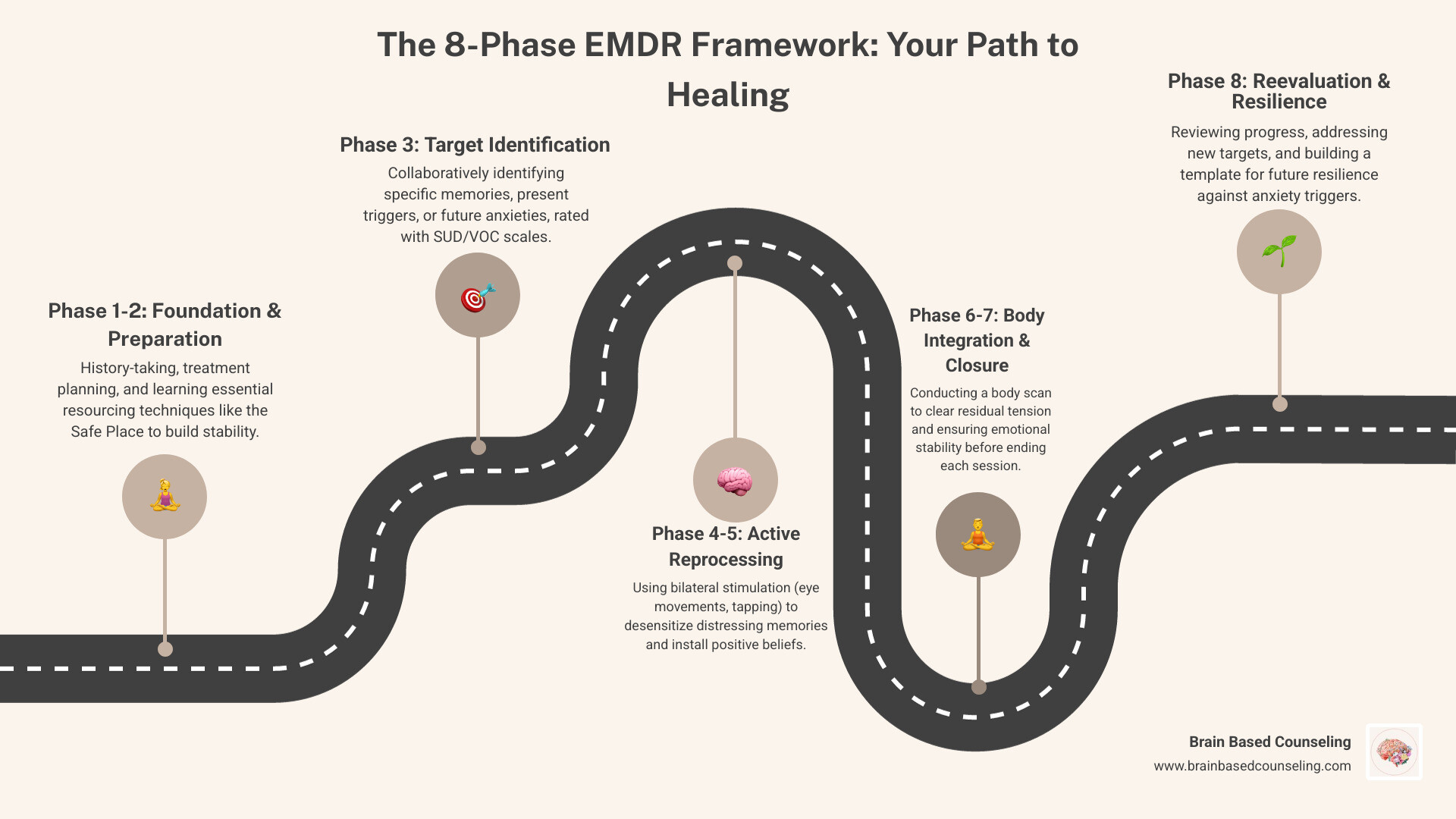EMDR Techniques for Anxiety: A Comprehensive Guide to Brain-Based Healing

Why EMDR Techniques for Anxiety Create Lasting Change
EMDR techniques for anxiety offer a powerful, brain-based path to healing that moves beyond symptom management. Rather than simply learning to cope, EMDR therapy targets the root cause of anxiety: the unprocessed traumatic memories and experiences that keep your nervous system in a constant state of high alert. This neuroscience-driven approach is particularly effective for high-achieving women and professionals dealing with anxiety disorders, perfectionism, or overwhelm who recognize that surface-level solutions aren't sufficient for their needs.
EMDR therapy works by helping your brain properly process and store difficult experiences that have become stuck in your neural networks. This addresses the underlying source of anxiety symptoms, including racing thoughts, physical sensations, emotional distress, panic attacks, and that persistent sense of being "on edge." The therapy targets the specific traumatic memories and painful memories that fuel your anxiety, allowing your nervous system to finally recognize safety in the present moment.
Developed by Francine Shapiro, eye movement desensitization and reprocessing (EMDR) is an evidence-based therapy technique that uses bilateral stimulation to help process traumatic memories and distressing experiences. The structured treatment process allows for systematic healing of the psychological and emotional issues that contribute to chronic anxiety. Research demonstrates that EMDR therapy can be highly effective for anxiety disorders and trauma-related conditions, often producing results more efficiently than traditional approaches.
This comprehensive guide explores the core EMDR techniques for anxiety used to create lasting change, covering both resourcing techniques for immediate calm and processing techniques for deep, therapist-guided healing. As a licensed clinical counselor specializing in EMDR intensive therapy, I provide targeted EMDR treatment through my solo practice, Brain Based Counseling, helping clients move from constant worry to genuine calm and confidence.
Understanding How EMDR Therapy Resolves Anxiety at Its Root
Anxiety serves as your body's alarm system, designed to alert you to potential threats. When anxiety becomes chronic, it's as if that alarm becomes stuck in the "on" position, creating a cascade of anxiety symptoms that impact every aspect of your life. Physical sensations may include a racing heart, muscle tension, and difficulty breathing. Emotional symptoms often manifest as irritability, dread, and a sense of impending doom. Cognitive symptoms typically involve racing "what if" thoughts, difficulty concentrating, and persistent worry about traumatic events or future scenarios.
The impact on daily life can be profound, affecting work performance, sleep quality, relationships, and overall mental health. For high-achieving individuals, this often creates a frustrating disconnect between external success and internal struggle with excessive anxiety and negative emotions.
Traditional talk therapy often focuses on managing these anxiety symptoms through coping strategies and cognitive techniques. EMDR therapy differs from conventional approaches by addressing the root cause through the Adaptive Information Processing (AIP) model. This model suggests that your brain has a natural system for processing and filing away experiences in a healthy manner.
When an experience involves traumatic events or overwhelming stress, this natural processing system becomes overloaded. The traumatic memories become stuck in their raw, unprocessed form, complete with all the original emotions, bodily sensations, and negative beliefs. These unprocessed traumatic experiences continue to trigger your nervous system, keeping it in a state of dysregulation—constantly prepared for fight, flight, or freeze responses.
Your brain doesn't distinguish between past threats and present safety, so these stuck memories continue to activate intense anxiety responses even when you're objectively safe. This explains why anxiety can feel so irrational and disconnected from current circumstances, and why anxiety triggers can seem to come from nowhere.
EMDR therapy works by helping to "unfreeze" these stuck memories through a process called bilateral stimulation. This involves guided eye movements, alternating tones, or tactile stimulation that activates both sides of the brain. The goal isn't to erase traumatic memories but to help your brain reprocess them so they're stored in a healthier, less distressing way.
During this reprocessing, several key changes occur through EMDR therapy sessions. The distressing memory loses its emotional intensity and no longer feels overwhelming when recalled. The intense physical sensations associated with the memory begin to fade. Your brain develops new, healthier neural pathways for responding to similar situations. Negative beliefs connected to the experience are replaced with more adaptive, positive belief systems about yourself and your capabilities.
This brain-based approach is central to the work at Brain Based Counseling, where the focus is on healing the underlying cause of your anxiety rather than simply managing symptoms. Through personalized EMDR intensive therapy, you can achieve genuine anxiety relief by addressing the root source of your distress.

The Science Behind EMDR: How and Why It Works
EMDR therapy, or eye movement desensitization and reprocessing, is grounded in decades of rigorous research and is recognized by major mental health organizations including the American Psychiatric Association and the World Health Organization. Originally developed to treat post traumatic stress disorder (PTSD), EMDR therapy has since been extensively researched and proven as an effective treatment for various anxiety disorders including generalized anxiety disorder, panic disorder, and posttraumatic stress disorder.
The science behind EMDR therapy centers on its unique ability to facilitate the brain's natural healing process. When you experience traumatic events or chronic stress, the memory of those traumatic experiences can become "stuck" in your nervous system. This creates a state where your brain continues to perceive threat even when you're safe, leading to persistent anxiety symptoms such as hypervigilance, difficulty relaxing, racing thoughts, and physical tension.
During EMDR therapy sessions, bilateral stimulation—most commonly through guided eye movements—helps the brain safely revisit distressing memories while simultaneously reducing their emotional intensity. This movement desensitization and reprocessing technique appears to mimic the brain's natural information processing that occurs during REM sleep, allowing for the integration and resolution of stuck memories.
Research demonstrates that EMDR therapy differs from traditional approaches by directly targeting how traumatic memories are stored in the brain. Rather than simply discussing or analyzing experiences, EMDR treatment facilitates actual neurological changes that reduce the memory's capacity to trigger anxiety responses. This leads to a significant reduction in anxiety symptoms and often rapid improvements, helping individuals regain a sense of control and emotional stability.
The therapy's effectiveness lies in its ability to work with your brain's innate healing capacity rather than against it. By providing the right conditions for natural processing to occur, EMDR therapy allows for genuine resolution of the underlying causes of anxiety disorders and related mental health conditions.
A Comprehensive Overview of EMDR Techniques for Anxiety
EMDR therapy follows a comprehensive, eight-phase protocol rather than being simply a collection of techniques. This trauma therapy approach is structured to ensure safe and effective treatment for reducing anxiety symptoms and processing traumatic experiences. Within this framework, specific interventions are used to address your unique needs and circumstances. These techniques generally fall into two categories: resourcing techniques that build stability and self-regulation skills, and processing techniques that involve deep, therapist-guided reprocessing of stuck memories.
At Brain Based Counseling, my EMDR practice is highly personalized to address the specific roots of your anxiety disorders. This ensures you develop a solid foundation of self-regulation skills while working through the deeper healing process of memory reprocessing. The approach recognizes that each person's anxiety has unique origins and manifestations, requiring individualized treatment planning and careful evaluation throughout the process.
Resourcing Techniques: Building Your Foundation for Healing
Resourcing techniques are designed to build your internal capacity to handle stress and expand what EMDR therapists call your "window of tolerance"—the zone in which you can experience emotions and sensations without becoming overwhelmed. These techniques provide immediate tools for self-regulation and can be used independently between EMDR therapy sessions for ongoing anxiety relief.
The Butterfly Hug is a simple, discreet self-administered bilateral stimulation technique that can provide rapid stress relief from anxiety symptoms. To practice this technique, cross your arms over your chest with your fingertips resting just below your collarbones. Gently alternate tapping your hands on your shoulders, mimicking the gentle flapping of butterfly wings, while breathing slowly and deeply. As you tap, simply observe any thoughts, feelings, or body sensations that arise without trying to change or judge them. This technique can be particularly helpful for managing panic attacks or sudden spikes in anxiety.
The Safe or Calm Place Exercise is a guided visualization that helps you create and access an internal sanctuary for reducing anxiety. During this process, you'll imagine a place where you feel completely safe, peaceful, and calm. This might be a real location from your past, an imagined peaceful setting, or even a symbolic representation of safety. You'll engage all your senses to make this place as vivid and real as possible—noticing what you see, hear, smell, feel, and even taste in this safe space.
Once the visualization is clear and calming, bilateral stimulation is used to anchor this feeling of safety and calm in your nervous system. This creates an internal resource that you can access whenever you need to feel grounded and secure, particularly when anxiety triggers arise.
The Container Exercise uses metaphorical imagery to help you manage overwhelming thoughts or negative emotions between therapy sessions. You'll imagine creating a secure container—perhaps a locked chest, a sealed vault, or any container that feels completely secure to you. When distressing thoughts or feelings arise outside of EMDR therapy sessions, you can visualize placing them in this container and sealing it securely until you can address the material safely in your next session.
This technique creates psychological distance from overwhelming material and provides a sense of control over intrusive thoughts or emotions. It's particularly helpful for high-achieving individuals who may struggle with persistent worries about work or performance, and those dealing with anxiety inducing memories.
Grounding Techniques and Relaxation Exercises help bring your focus to the present moment, calming an overactive nervous system. One effective method is the 5-4-3-2-1 technique: identify 5 things you can see, 4 things you can physically feel, 3 things you can hear, 2 things you can smell, and 1 thing you can taste. This engages your senses and anchors your awareness in the present moment rather than in anxious thoughts about the future or distressing memories from the past.

Processing Techniques: Deep Healing with Professional Guidance
While resourcing techniques provide valuable self-management tools, the transformative heart of EMDR therapy lies in the processing phases. These techniques must always be conducted by a qualified EMDR therapist to ensure both safety and effectiveness as you work through the root causes of your anxiety disorders.
Target Identification involves working collaboratively to pinpoint the specific memories, beliefs, or anxiety triggers that fuel your symptoms. This comprehensive assessment includes past traumatic events that may have contributed to current anxiety patterns, present-day triggers that activate your nervous system, and future-oriented worries that create anticipatory anxiety.
During this process, negative beliefs associated with these targets are identified (such as "I am not safe" or "I am powerless"), and the level of distress is measured using standardized scales. This creates a clear roadmap for the EMDR treatment process ahead.
Dual Attention Stimulation represents the core of desensitization and reprocessing EMDR therapy. During this phase, you'll focus on a targeted memory while simultaneously engaging in bilateral stimulation through guided eye movements, alternating tones, or tactile stimulation. This dual attention allows your brain to make new connections and associations while reprocessing the stuck memory.
The bilateral stimulation continues until the traumatic memory no longer carries the same emotional intensity. This doesn't mean the memory is erased, but rather that it loses its power to trigger overwhelming anxiety responses. The therapist evaluates progress throughout this process and adjusts the approach as needed.
Body Scan Techniques are used after the emotional charge of a memory has been reduced to address any lingering physical sensations or tension. You'll mentally scan your body from head to toe, noting any areas of discomfort, tension, or unusual bodily sensations. Additional bilateral stimulation is then used to help release these physical holdings, ensuring that healing occurs on both emotional and somatic levels.
This body-based component is crucial because trauma and anxiety often manifest as much in the body as in the mind. By addressing both psychological and physical aspects, EMDR therapy provides comprehensive healing and helps prevent the return of anxiety symptoms.
The 8-Phase EMDR Framework: Your Structured Path to Healing
EMDR therapy follows a comprehensive eight-phase protocol that serves as a roadmap for safe and effective healing. This structured approach ensures that every aspect of your recovery from anxiety disorders is addressed systematically, building from a foundation of stability to deep processing and integration.
Phase 1-3: Preparation and Assessment
The initial phases establish the groundwork for successful EMDR treatment. Phase 1: History-Taking and Treatment Planning involves a thorough exploration of your history, current anxiety symptoms, and treatment goals. Together, we identify the specific traumatic memories, beliefs, or triggers that contribute to your anxiety disorders, creating a comprehensive treatment plan tailored to your unique needs.
Phase 2: Preparation focuses on building your toolkit of self-regulation skills for treating anxiety. You'll learn essential resourcing techniques like the Butterfly Hug and Safe Place visualization, ensuring you have immediate tools for managing anxiety symptoms and stress. This phase also involves psychoeducation about the EMDR therapy process and establishing the strong therapeutic relationship that supports deeper work.
Phase 3: Assessment involves activating a specific targeted memory and identifying the associated negative beliefs and preferred positive beliefs. Baseline measurements are established using standardized scales to track progress throughout the processing and ensure effective anxiety treatment.
Phase 4-6: Active Reprocessing
These phases represent the core healing work of EMDR therapy for reducing anxiety symptoms. Phase 4: Desensitization uses bilateral stimulation to reduce the emotional disturbance associated with traumatic memories. This continues until the memory no longer feels distressing when brought to mind, resulting in significant reduction of anxiety symptoms.
Phase 5: Installation focuses on strengthening positive beliefs identified earlier in the process. Through continued bilateral stimulation, adaptive beliefs are reinforced until they feel completely true and solid, replacing the negative beliefs that previously fueled anxiety.
Phase 6: Body Scan ensures that healing is complete on a somatic level. Any remaining physical tension or discomfort related to the processed memory is addressed through additional bilateral stimulation, ensuring comprehensive resolution of both emotional and physical aspects of anxiety.
Phase 7-8: Integration and Future Preparation
The final phases focus on integration and preparation for ongoing resilience in treating anxiety. Phase 7: Closure ensures you feel calm and stable at the end of each EMDR session, using resourcing techniques to maintain emotional equilibrium and prevent any lingering distress.
Phase 8: Reevaluation begins each subsequent EMDR therapy session by checking on previous work to ensure that changes remain stable and identifying any new material that has emerged. This builds a template for future resilience and continued growth in your anxiety treatment journey.

Frequently Asked Questions About EMDR Therapy for Anxiety
How long does EMDR therapy take to work for anxiety disorders?
The timeline for EMDR therapy varies significantly based on individual factors and the complexity of your anxiety symptoms. For anxiety rooted in a single, specific traumatic event, meaningful relief often occurs within just a few EMDR therapy sessions. However, anxiety stemming from multiple traumatic experiences or complex trauma naturally requires more time as we address the various contributing factors systematically through the treatment process.
EMDR intensive therapy can be particularly effective for individuals with demanding schedules. These concentrated EMDR sessions, lasting 4-6 hours per day over 1-3 consecutive days, allow for significant progress in a condensed timeframe. This format is especially beneficial for high-achieving professionals who want to maximize their therapeutic investment while treating anxiety effectively.
While timelines vary, EMDR therapy is generally more efficient than many traditional approaches because it works directly with your brain's natural processing systems rather than relying solely on cognitive strategies for reducing anxiety symptoms.
Can I use EMDR techniques for anxiety on my own?
This important question has a nuanced answer regarding EMDR practice. Resourcing techniques—including the Butterfly Hug, Safe Place visualization, grounding exercises, and the Container technique—are specifically designed for independent use. These skills become part of your personal toolkit for managing anxiety symptoms and stress in daily life, providing immediate anxiety relief when needed.
However, the processing phases of EMDR therapy must always be conducted with a qualified EMDR therapist. Attempting to reprocess traumatic memories or distressing material independently can be overwhelming and potentially harmful. A trained EMDR therapist provides the safety, guidance, and clinical expertise necessary for effective memory reprocessing and treating anxiety disorders safely.
EMDR practitioners undergo extensive training through the EMDR International Association to ensure they can provide this safe and effective treatment for various mental health conditions.
What should I look for in an EMDR therapist for anxiety treatment?
Choosing the right EMDR therapist is crucial for successful anxiety treatment. Consider asking about their specific training and certification through the EMDR International Association (EMDRIA), their experience in treating anxiety disorders and related conditions, and their familiarity with your particular challenges, such as high-functioning anxiety, panic disorder, or trauma-related concerns.
At Brain Based Counseling, the focus is specifically on serving high-achieving women and professionals dealing with anxiety disorders, trauma, and PTSD through specialized EMDR practice. This specialization ensures deep understanding of the unique challenges faced by motivated individuals who may appear successful externally while struggling internally with anxiety symptoms.
Beyond credentials and experience in EMDR therapy, trust your instincts about the therapeutic relationship. A strong connection with your EMDR therapist provides the foundation for safe and effective healing, particularly when treating PTSD and complex anxiety disorders.

Transform Your Relationship with Anxiety Through EMDR Therapy
EMDR techniques for anxiety offer a transformative approach that goes far beyond symptom management. By targeting the unprocessed traumatic memories and experiences that fuel chronic anxiety, EMDR therapy facilitates genuine healing at the neurological level. This brain-based approach recognizes that lasting change occurs when we address root causes rather than simply managing surface anxiety symptoms.
The power of EMDR therapy lies in its comprehensive approach, combining immediate self-regulation tools with deep, therapist-guided processing of stuck memories. For high-achieving individuals who may excel professionally while struggling with internal anxiety disorders, perfectionism, or overwhelm, this approach offers hope for genuine resolution and significant reduction in anxiety symptoms.
At Brain Based Counseling, the focus is on providing personalized EMDR intensive therapy that honors your unique history, current challenges, and healing goals. Through this neuroscience-driven, trauma-informed approach using eye movement desensitization and reprocessing, you can move from surviving to thriving, reclaiming the calm and confident life you deserve.
The structured eight-phase EMDR therapy framework provides a proven, safe pathway toward healing from anxiety disorders and related mental health conditions. Whether you're seeking support through in-person EMDR sessions in the Cincinnati, Ohio area or virtual sessions throughout Ohio and North Carolina, specialized care is available to help you transform your relationship with anxiety through this effective treatment approach.
If you're ready to move beyond managing anxiety symptoms and step into a life of greater peace and resilience, EMDR therapy offers a powerful and effective path forward. The journey from chronic worry to genuine calm is possible through this evidence-based, brain-based approach to healing that has helped countless individuals overcome anxiety disorders and reclaim their lives.
To learn more about how EMDR intensive therapy can address your specific needs in treating anxiety or to schedule a consultation, reach out to Brain Based Counseling. Your path to healing and transformation begins with a single step toward understanding that lasting change through EMDR therapy is not only possible but within your reach.
